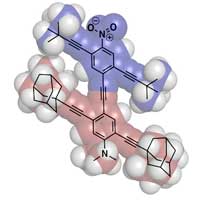 Scientists has synthesized graphene nanoribbons on a titanium dioxide surface using an atomically precise method that removes a barrier for custom-designed carbon nanostructures required for quantum information sciences.
Scientists has synthesized graphene nanoribbons on a titanium dioxide surface using an atomically precise method that removes a barrier for custom-designed carbon nanostructures required for quantum information sciences.
Monday, October 26, 2020
On-surface synthesis of graphene nanoribbons could advance quantum devices
 Scientists has synthesized graphene nanoribbons on a titanium dioxide surface using an atomically precise method that removes a barrier for custom-designed carbon nanostructures required for quantum information sciences.
Scientists has synthesized graphene nanoribbons on a titanium dioxide surface using an atomically precise method that removes a barrier for custom-designed carbon nanostructures required for quantum information sciences.
Researchers roll out the next generation of single-molecule race cars
 Nanoengineers are getting ready to rev their engines for the second international Nanocar Race.
Nanoengineers are getting ready to rev their engines for the second international Nanocar Race.
Could a nasal spray repair brain cells?
 An inexpensive, accessible and non-invasive therapy for diseases and injuries of the brain may be slowly emerging: tiny particles called extracellular vesicles (EVs). Unlike stem cell therapies for repairing brain damage, EVs may safely regenerate brain cells and reduce inflammation.
An inexpensive, accessible and non-invasive therapy for diseases and injuries of the brain may be slowly emerging: tiny particles called extracellular vesicles (EVs). Unlike stem cell therapies for repairing brain damage, EVs may safely regenerate brain cells and reduce inflammation.
A 2D derivative of perovskite shows potential for valleytronics applications
 Engineers have found a 2D material that could make computers faster and more energy-efficient. Their material is a derivative of perovskite that has the surprising ability to enable the valleytronics phenomenon touted as a possible platform for information processing and storage.
Engineers have found a 2D material that could make computers faster and more energy-efficient. Their material is a derivative of perovskite that has the surprising ability to enable the valleytronics phenomenon touted as a possible platform for information processing and storage.
Tiny golden bullets could help tackle asbestos-related cancers
 Researchers demonstrate that gold nanotubes could be used to treat mesothelioma, a type of cancer caused by exposure to asbestos.
Researchers demonstrate that gold nanotubes could be used to treat mesothelioma, a type of cancer caused by exposure to asbestos.
A new graphene-based testing system for disease-related antibodies
 The new instrument, based on the principle of a quartz-crystal microbalance combined with a graphene-based bio-interface, offers a cheap, fast, simple and sensitive alternative to currently available antibody tests.
The new instrument, based on the principle of a quartz-crystal microbalance combined with a graphene-based bio-interface, offers a cheap, fast, simple and sensitive alternative to currently available antibody tests.
Subscribe to:
Comments (Atom)
